
About UsThe Numismatic Bibliomania Society is a non-profit organization promoting numismatic literature. For more information please see our web site at coinbooks.org SubscriptionsThose wishing to become new E-Sylum subscribers (or wishing to Unsubscribe) can go to the following web page link MembershipThere is a membership application available on the web site Membership Application To join, print the application and return it with your check to the address printed on the application. Membership is only $15 to addresses in the U.S., $20 for First Class mail, and $25 elsewhere. For those without web access, write to: David M. Sundman, Treasurer AsylumFor Asylum mailing address changes and other membership questions, contact David at this email address: dsundman@LittletonCoin.com SubmissionsTo submit items for publication in The E-Sylum, just Reply to this message, or write to the Editor at this address: whomren@gmail.com
BUY THE BOOK BEFORE THE COIN |
- WAYNE'S WORDS: THE E-SYLUM NOVEMBER 10, 2013
- DAVIS LITERATURE SALE CLOSES NOVEMBER 16, 2013
- SKLOW TO OFFER GRADY AND MOULTON LIBRARIES IN 2014
- NEW BOOK: WAMPUM AND THE ORIGINS OF AMERICAN MONEY
- BOOK REVIEW: MONNAIE ET JETONS DE L’INDOCHINE FRANÇAISE
- BOOK REVIEW: JAPANESE OCCUPATION OF MALAYA (SINGAPORE) AND ITS CURRENCY
- Q. DAVID BOWERS ON NUMISMATIC BOOKS AND NBS
- PRINCETON ACQUIRES LANDMARK MEDIEVAL EGYPTIAN COIN COLLECTION
- MORE ON FRACTIONAL MONEY BY CAROTHERS
- NOTES FROM E-SYLUM READERS: NOVEMBER 10, 2013
- ERIC NEWMAN WEEK IN BERGEN COUNTY, NJ
- ANS PUBLISHES EDWARD SAWYER’S NATIVE AMERICANS MEDALS ONLINE
- MORE ON MARY B. BLANKENBUEHLER
- MOUNT RUSHMORE QUARTER LAUNCH CEREMONY
- AUSTRALIA'S FANTASY GOOSE DOLLAR COINS
- 2014 BASEBALL COIN CHALLENGES U.S. MINT STAFF
- U.S. MINT TEAMS WITH NATIONAL ENDOWMENT FOR THE ARTS
- INTERNET ARCHIVE SCANNING CENTER BURNS
- WAYNE'S NUMISMATIC DIARY: NOVEMBER 10, 2013
- ALAN WEINBERG'S NOVEMBER 2013 BALTIMORE SHOW REPORT
- DAVID SUNDMAN'S MASSACHUSETTS SILVER POST-AUCTION REPORT
- THE FAMED FORGER JOSEPH-SAMUEL FARINET
- SPANISH PROTESTERS PUTTING COMPLAINTS ON BANKNOTES
- THE PERTH REGIMENT ITALIAN LIRE SHORT SNORTER
- THE BRITISH NAVAL GENERAL SERVICE MEDAL
- EURO COINS COST TWICE FACE VALUE TO MINT
- FLORIDA STATE UNIVERSITY CHALLENGE COINS
- FEATURED WEB SITE: ALL ENGELHARD
Click here to access the complete archive
To comment or submit articles, reply to whomren@gmail.com
WAYNE'S WORDS: THE E-SYLUM NOVEMBER 10, 2013

New subscribers this week include Dr. Peter Jacobsohn, courtesy of Neil Shafer, and Matt Powell. Welcome aboard! We have 1,680 email subscribers, plus 250 followers on Facebook.
First, a word about a new ad this week. The seller is offering printing plates from a numismatic book. The book illustrates obsolete notes. The book is in small format and the images are small. Although neither I nor the seller own examples of the notes, I believe these images are smaller than actual size and would likely not be able to be used to make believable fakes of the notes. With the plates coming on the market they will find a new home with or without The E-Sylum, and I felt that their existence could be better documented here to make the hobby aware of them. It's an unusual set of items that will need just the right buyer.
This week we open with updates from literature dealers Charlie Davis and David Sklow, one new book and reviews of two others. Next is a note from Dave Bowers on numismatic books and the NBS, and word of a new acquisition for Princeton University.
Other topics include Fractional Money by Carothers, fantasy and nonsense coins, short snorters, challenge coins and three numismatic diaries from the Whitman Baltimore show.
To learn more about Charles W. Engelhard, Wampum, Japanese Occupation currency, Australian Goose Dollars, the British Naval General Service Medal and the 1755 limmed 4 Escudos of Nuevo Reino, read on. Have a great week, everyone!
Wayne Homren
Editor, The E-Sylum
DAVIS LITERATURE SALE CLOSES NOVEMBER 16, 2013
Charles Davis' sale of numismatic literature will close this Saturday November 16. The sale will feature The Michael Sullivan Collection of The Works of Wayte Raymond with additions from the libraries of John W. Adams, Gordon Frost and Rob Retz. the catalogue is posted on our website, www.numisbook.com , and some 350 photographs have been posted there as well. Highlights include, in no particular order
- Museum Mazzuchellianum Catalogue 1761-1763
- Howard Newcomb’s card file with full descriptions in his hand of 1000 cents that comprised his collection
- New Netherlands catalogues complete, 6 volumes bound in Morocco
- William Sheldon’s copy of Wurtzbach Plates of Massachusetts Silver
- Dennis Cooper: The Art and Craft of Coin Making
- Henry Chapman’s signed copy of Low’s Hard Times Tokens with Adams Plates
- W. E. Woodward catalogues - 91 of the 108 numbered sales
- The Numismatist, 1921-1971 complete, bound in cloth
- T. Harrison Garrett’s copy of Slafter on Vermonts
- Peter Gschwend, James B. Wilson, Malcolm Jackson catalogues with Plates
- Revue Belge de Numismatique et de Sigilllographie 1904-1940 complete
- Crosby’s Early Coins of America, 3 different, one with Maris Plate
- Beazel: United States Counterfeit Detector
- Clapp & Newcomb The Cents of 1795-1814 handsomely bound as one
- Near Complete Run of the catalogues of M. L. Bolender
- Richard Eliasberg’s Deluxe Eliasberg/Brand Catalogue
- Dorothy & Grenville Bathe on Jacob Perkins
- Milwaukee 1986 Special Red Book signed by Yeoman
- Penny Wise and Colonial Newsletter, bound sets
Charles Davis
Box 547
Wenham Mass 01984
E-Mail: Numislit@aol.com
Web Site: www.Numisbook.com
SKLOW TO OFFER GRADY AND MOULTON LIBRARIES IN 2014
Hello fellow book lovers!
We are very excited to announce some of our 2014 schedule of auction events; starting with our February 15, 2014 auction, which will feature the working library of Numismatic Literature Dealer Orville 'Jim' Grady, along with other consignors. Our June 15, 2014 and October 11, 2014 sales will feature Part I & II of the vast library of Numismatic Literature Dealer Karl Moulton.
These offerings are quite different in content. With the Orville Grady sale you will see many standard references, special editions, a hint of international numismatics, rare ANA photographs and more. The Karl Moulton library will feature a massive offering of catalogs of the early and mid-twentieth century, with many deluxe and plated editions, and vast runs of periodicals. A later sale [or two] will feature Karl's nineteenth century auction catalogs.
Attached are some of the highlights in our February 15th Sale # 21.
David Sklow-Fine Numismatic Books
P.O. Box 6321
Colorado Springs, CO 80934
PH: 719-302-5686
FAX: 719-302-4933
Email: numismaticbooks@aol.com
Web Site: FineNumismaticBooks.com
- RARE OFFICIAL CONVENTION PHOTOGRAPHS OF THE AMERICAN NUMISMATIC ASSOCIATION 1925-1937.
- VERY RARE 1930 SILVER ANA CONVENTION MEDAL, BUFFALO N.Y.
- RARE 1947 THREE PIECE ANA CONVENTION MEDAL SET [BRONZE-SILVER-GOLD], BUFFALO, N.Y.
- SCARCE 1910 ANA CONVENTION BADGE, N.Y.C.
- SCARCE 1914 ANA CONVENTION BADGE, SPRINGFIELD, MA.
- SCARCE 1921 ANA CONVENTION MEDAL & BADGE, BOSTON, MA.
- RARE 1932 ANA CONVENTION BADGE, LOS ANGELES, CA.
- EXTREMELY RARE 1958 SPECIAL GOLD-FILLED CONVENTION BADGE WITH GOLD COMMITTEE HANGAR.
- OTHER ASSORTED ANA BADGES & MEDALS, AND MEDAL SETS FROM THE 1920'S TO 1970'S.
- THE ART AND CRAFT OF COIN MAKING BY COOPER.
- TRADESMEN'S TOKENS OF THE EIGHTEENTH CENTURY BY ATKINS
- EARLY ISSUES OF THE AMERICAN JOURNAL OF NUMISMATICS 1866-1890
- FIXED PRICE LIST & PRICES PAID FOR LISTS OF U.S. COIN DEALERS VOLUMES I, II & III BY BOURNE.
- EARLY AMERICAN CAR ADVERTISEMENTS, 1966, BY Q. DAVID BOWERS.
- Q. DAVID BOWERS NUMISMATIST: BULLETIN NO. 2.
- DELUXE HENRY H. CLIFFORD SALE BY BOWERS & RUDDY.
- DELUXE THREE VOLUME SET OF THE NORWEB SALES BY BOWERS & MERENA.
- ORIGINAL LEATHER BOUND SIX VOLUME SET OF ANNALS OF THE COINAGE OF BRITAIN WITH THE SEVENTH SUPPLEMENTAL VOLUME, 1819 BY RUDING.
- NUMEROUS DELUXE EDITIONS OF G.F. KOLBE AUCTION CATALOGS IN CLOTH AND FULL LEATHER.
- COMPLETE SET OF AUCTION CATALOGS OF JOSEPH LEVINE [PRESIDENTIAL COIN & ANTIQUES].
- LONG RUN OF OFFICIAL ANA CONVENTION AUCTION CATALOGS [1939-1986] PRIVATELY UNIFORMLY BOUND IN BLACK WITH JAMES THOMPSON IN GILT.
- DELUXE LEATHER NUMBERED 114 OF 135 A REGISTER OF HALF DOLLAR DIE VARIETIES AND SUB VARIETIES BY BEISTLE.
- DELUXE QUARTER LEATHER WORLD'S GREATEST COLLECTION U.S. SILVER COINS.
- DELUXE QUARTER LEATHER WORLD'S GREATEST COLLECTION U.S. GOLD COINS.
- SUPER DELUXE FULL LEATHER WORLD'S GREATEST COLLECTION U.S. SILVER COINS, WITH SLIPCASE, INSCRIBED TO HAROLD BAREFORD BY ABE KOSOFF & ABNER KREISBERG.
- DELUXE QUARTER LEATHER U.S. GOLD COINS AND TERRITORIAL GOLD - NUMISMATIC GALLERY, 1948 INSCRIBED TO HAROLD BAREFORD BY ABE KOSOFF & ABNER KREISBERG.
- DELUXE BOUND NUMBERED NO. 11 ADOLPHE MENJOU CATALOGUE, INSCRIBED TO HAROLD BAREFORD BY ABE KOSOFF & ABNER KREISBERG.
- DELUXE BOUND NUMBERED NO. 4 T. JAMES CLARKE & THOMAS MELISH CATALOGUE, INSCRIBED TO HAROLD BAREFORD BY ABE KOSOFF & ABNER KREISBERG.
- DELUXE BOUND NUMBERED NO. 9 JAMES SLOSS COLLECTION.
- DELUXE BOUND NUMBERED NO. 63 EDWARD SCHWARTZ CATALOGUE, INSCRIBED TO HAROLD BAREFORD BY ABE KOSOFF.
- DELUXE BOUND EDWIN HYDEMAN CATALOGUE, INSCRIBED TO HAROLD BAREFORD BY ABE KOSOFF.
- MANY OTHER DELUXE CATALOGS FROM THE LATE HAROLD BAREFORD.
- RARE UNIQUE PREPUBLICATION PASTE UP'S OF THE AUCTION CATALOGS OF ORVILLE 'JIM' GRADY.
- COMPLETE SET OF CAL WILSON LITERATURE CATALOGS.
- COMPLETE SET OF CAL WILSON'S NUMISMATIC REPOSITORY.
- COMPLETE SET OF 'OUT ON A LIMB' THE MONEY TREE BY KEN LOWE & MYRON XENOS.
- SMALL SIZE COIN CABINET, ONCE BELONGING TO DAVE HESS.
- COMPLETE FOUR VOLUME SET A HISTORY OF BANKING IN ALL THE LEADING NATIONS, 1896.
- DELUXE FULL LEATHER CALIFORNIA GOLD DOLLARS, HALF DOLLARS, QUARTER DOLLARS, 1979 BY KENNETH LEE, PUBLISHED BY G.F. KOLBE. WITH ORIGINAL PURCHASE RECEIPT OF ARMAND CHAMPA.
THE BOOK BAZARRE
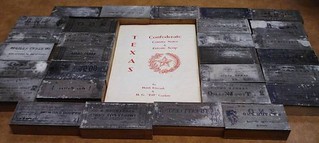
Bill Goglas: goglasbill@yahoo.com
NEW BOOK: WAMPUM AND THE ORIGINS OF AMERICAN MONEY
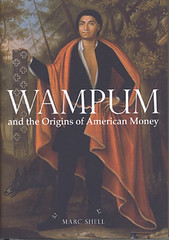 WAMPUM and the Origins of American Money
by Marc Shell
WAMPUM and the Origins of American Money
by Marc Shell
University of Illinois Press
in association with the American Numismatic Society
Publication date: October 23, 2013
Hardback, cloth. 168 pages, 18 color, 101 B&W photographs
ISBN: 978-0-252-03366-7
Wampum has become a synonym for money, and is widely assumed that it served the same purposes as money among the Native Algonquians even after coming into contact with European colonists’ money. But to equate wampum with money only matches one slippery term with another, as money itself was quite ill-defined in North America for decades during its colonization. In this stimulating and intriguing book, Mark Shell illuminates the context in which wampum was used by describing how money circulated in the colonial period and the early history of the United States.
Wampum itself, generally tubular beads made from clam or conch shells, was hardly a primitive version of a coin or dollar bill, as it represented to both Native Americans and colonial Europeans a unique medium through with language, art, culture, and even conflict were negotiated. With impressive wit and erudition, Shell interweaves wampum’s multiform functions and reveals wampum’s undeniable influence on the cultural, political, and economic foundations of North America.
about the author Marc Shell is the Irving Babbitt Professor of Comparative Literature and professor of English at Harvard University. He is the author of many books, including The Economy of Literature and Money, Language, and Thought
To order, see: numismatics.org/Store/Wampum
BOOK REVIEW: MONNAIE ET JETONS DE L’INDOCHINE FRANÇAISE
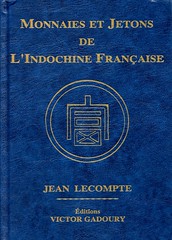 Éditions Victor Gadoury present Jean Lecompte’s new book on coins and tokens of French Indochina
Éditions Victor Gadoury present Jean Lecompte’s new book on coins and tokens of French Indochina
There are just very few numismatic markets like the Asian market which has grown incredibly within the last years. French colonial coins are now the highlights of a sale, as many new collectors from the Indochina Peninsular are interested in testimonies of their own history. These new collectors have started to build very ambitious collections, which has triggered a boom of coins and tokens from Indochina. Éditions Victor Gadoury is taking this into account. Until now there was one catalogue featuring all coins and tokens of the French colonies. Now this reference book has been divided into three – considerable more extensive – volumes. The first volume, coins and tokens of French Indochina has just been published.
This book is not only meant for the French collector. All the historical and numismatic texts are bilingual: French and English. In addition the author adds a glossary, which helps to understand easily the technical data given in the catalogue.
The following regions are treated in the catalogue: Annam, the kingdom of Cambodia, the French trading posts in China (Kwang-Chou-Wan, Shanghai, Tianjin), Cochinchina, Indochina, Laos, Siam, Tonkin, Vietnam.
Each chapter is introduced by a bilingual historical commentary on the region. The catalogue of all coins and tokens follows. Each region is equipped with its own numbering. Most of the coin types are illustrated in color. You will also find all technical data there as well as the mintage. Some remarkable medals illustrate the text, too. The prices are given for three to five conditions depending on the coin type.
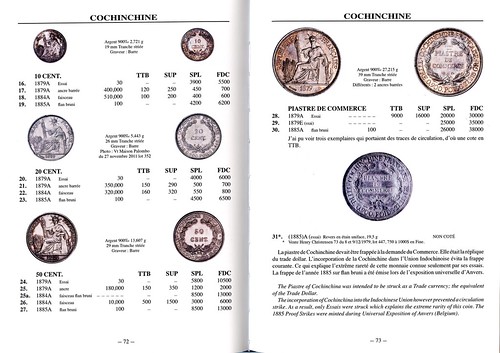
Bibliographic data: Jean Lecompte, Monnaies et Jetons de L’Indochine Française. Éditions Victor Gadoury, Monaco 2013. Hardcover. Stichbinding. 20,5 x 14,5 cm. 168 pages fully illustrated in color. ISBN 978-2-906602-42-7. 49 Euro. You can order directly at www.gadoury.com
To read the earlier E-Sylum article with Serge Pelletier's review, see: BOOK REVIEW: MONNAIE ET JETONS DE L’INDOCHINE FRANÇAISE (www.coinbooks.org/esylum_v16n45a07.html)
BOOK REVIEW: JAPANESE OCCUPATION OF MALAYA (SINGAPORE) AND ITS CURRENCY
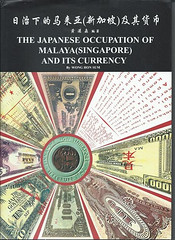 I saw a book by Wong Hon Sum entitled The Japanese Occupation of Malaya (Singapore) and its Currency. The 1996 book, in Chinese and English is by Wong Hon Sum, and contains numerous color illustrations of JIM, various emergency issues from the region, replicas, counterfeits and fantasies, propaganda pieces and overprints among other things. I was told that only about two-hundred copies of the book were printed and that most "disappeared" in Singapore shortly after its release. While a number of the notes and paper issues are those we have seen many times before, the book also contains quite a few items that I have never seen and they merit more study
I saw a book by Wong Hon Sum entitled The Japanese Occupation of Malaya (Singapore) and its Currency. The 1996 book, in Chinese and English is by Wong Hon Sum, and contains numerous color illustrations of JIM, various emergency issues from the region, replicas, counterfeits and fantasies, propaganda pieces and overprints among other things. I was told that only about two-hundred copies of the book were printed and that most "disappeared" in Singapore shortly after its release. While a number of the notes and paper issues are those we have seen many times before, the book also contains quite a few items that I have never seen and they merit more study
For more information on the MPCGram, write to: MPCGram@yahoo.com
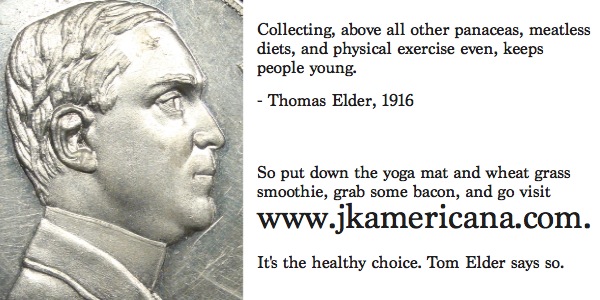
Q. DAVID BOWERS ON NUMISMATIC BOOKS AND NBS
 There has been a revival of sorts in the popularity of printed books.
There is something special about having a bound book with printed pages that you can hold in your hand, take to the beach, read in an easy chair at home, and otherwise enjoy at leisure. A printed book has random access -- you can flip to any page you want -- requires no batteries or power, has nice graphics and, perhaps more important, has a permanence. Our old auction catalogs are enthusiastically collected -- far more than those of any other contemporary firm. The Ford Collection hard bounds are the latest in an illustrious series. It could be that the same amount of information if posted on the Internet would be just as useful, sort of, but something would be lost. A book in its own way is a little trophy, perhaps like a special watch or car is.
There has been a revival of sorts in the popularity of printed books.
There is something special about having a bound book with printed pages that you can hold in your hand, take to the beach, read in an easy chair at home, and otherwise enjoy at leisure. A printed book has random access -- you can flip to any page you want -- requires no batteries or power, has nice graphics and, perhaps more important, has a permanence. Our old auction catalogs are enthusiastically collected -- far more than those of any other contemporary firm. The Ford Collection hard bounds are the latest in an illustrious series. It could be that the same amount of information if posted on the Internet would be just as useful, sort of, but something would be lost. A book in its own way is a little trophy, perhaps like a special watch or car is.
Further speaking of books, the Numismatic Bibliomania Society is one of our favorite organizations. It is devoted to the enjoyment of out-of-print as well as current coin magazines, auction catalogs, reference books, printed broadsides and more. Their quarterly journal, The Asylum, is one of the best “reads” to cross my desk. The current issue included articles about Emmanuel J. Antinelli, father of collecting numismatic auction catalogs by John W. Adams; a related article also by Adams, about Antinelli himself; a feature by Pete Smith and Joel Orosz as to what the first publication was of the second United States Mint (the cornerstone for which was laid on July 4, 1829); “Reminiscences of a Numismatic Bookseller,” by George Kolbe; a quiz by Myron Xenos; and other features by David Fanning, Scott Rubin, Wayne Johnson, Elizabeth Hahn, Steve Tompkins and, again, Joel Orosz. The remarkable thing about the society is that dues are just $20 a year! If you are interested, send a check for that amount to the treasurer, David M. Sundman, PO Box 82, Littleton, NH 03561 and say that I sent you!
To read the complete article, see: From The Desk Of Q. David Bowers: More This And That (stacksbowers.com/Blogs/from-desk-of-q-david-bowers-more-this.html)
PRINCETON ACQUIRES LANDMARK MEDIEVAL EGYPTIAN COIN COLLECTION
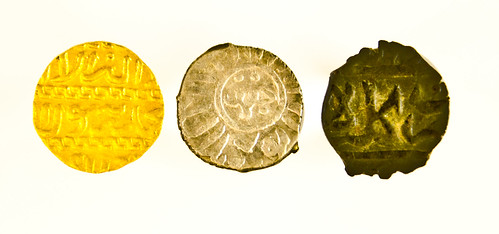
Mamluk coins from the Richard E. Undeland Collection at Princeton University: Al-Zahir Abu Sa'id Jaqmaq, Sultan of Egypt AH 842-57 (CE 1438-53): gold dinar, Cairo mint; silver dirham, Damasus mint; bronze fals (no mint).
Princeton University has just acquired the Richard Undeland Collection of Mamluk coins as part of its goal of building a comprehensive study collection of the coinage of the medieval Mediterranean. The Undeland Collection was purchased for the University's Numismatic Collection, part of Firestone Library's Department of Rare Books and Special Collections, by the Friends of Princeton University Library. Donald Farren, Chair of the FPUL, stated, "The Friends of the Library are happy to have been able to fund this important addition to our resources for teaching, learning, and scholarship—helping to make our great Princeton University Library even greater."
The landmark collection was assembled by Richard E. Undeland, a U.S. foreign service officer who spent the majority of his 35-year career in the Middle East. Mr. Undeland spent countless hours scouring the souks of Cairo, Damascus, and other cities searching for Medieval Islamic These included Mamluk coins, which were struck for every one of the fifty sultans who ruled Egypt and the surrounding territories between 1250 (AH 648) and 1516 (AH922). By the time of his retirement in 1992, Mr. Undeland's quest to capture every sultan was complete: the collection features at least one example struck for each Mamluk ruler. After Mr. Undeland passed away in 2012, his wife, Joan, sought out Princeton University's Numismatic Collection as a fitting permanent home where the collection can be studied and enjoyed.
Alan Stahl, Curator of Numismatics, remarked that "the acquisition of the Undeland Collection is an important step in building our holdings of the coinage of the eastern Mediterranean in the Middle Ages, following our systematic strengthening in recent years of our Byzantine holdings and the purchase of the Latin Orient Collection of Crusader Coins and the Armenian Heritage Collection, all with the generous support of the Stanley J. Seeger Hellenic Fund. We have also been fortunate in acquiring the Scott Redford Collection of Turcoman coins. All of this is in addition to the approximately 10,000 post-classical coins in our collection from the Princeton excavations at Antioch-on-the-Orontes in the 1930s, and the combined gifts of a century and a half of generous donors. We are now setting our sights on finding similar resources to build up our representation of coins of the western Mediterranean in the medieval period."
For more information on the Princeton collection, see: The Princeton University Numismatic Collection (www.princeton.edu/~rbsc/department/numismatics/)
THE BOOK BAZARRE
MORE ON FRACTIONAL MONEY BY CAROTHERS
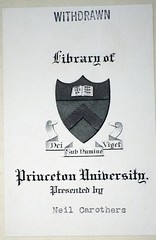 Regarding Fractional Money, David Sundman writes:
Regarding Fractional Money, David Sundman writes:
I greatly enjoyed David Ginsburg’s review of Carothers’ excellent book, and slipped a copy of it into my own hardcover copy. I thought readers might enjoy the attached 12/19/1963 typed note inside my copy, and the Princeton University Library presentation bookplate with “Presented by Neil Carothers” imprint.
As to the author of the note, I can’t recall where I bought the book now—and offhand I don’t know who JPR or TLC are or were. I am guessing the “JPR” who managed to coax the book out of Princeton’s Library was or is of a Continental or English background, as the date is expressed “19 December, 1963” --- or he or she could just be an Anglophile

To read the earlier E-Sylum article, see: BOOK REVIEW: FRACTIONAL MONEY BY CAROTHERS (www.coinbooks.org/esylum_v16n45a08.html)
NOTES FROM E-SYLUM READERS: NOVEMBER 10, 2013
More on St. Eligius
Pabitra Saha writes:
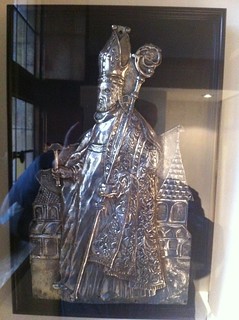
Here is an image of St. Eligius from a local (Antwerp) silver museum. Sorry for poor photo as it was using a mobile phone.
To read the earlier E-Sylum article, see:
MORE ON THE SAINT ELIGIUS MEDAL
(www.coinbooks.org/esylum_v16n45a21.html)
Robert Coulton Davis Photo
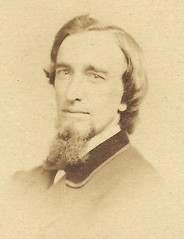 Regarding David Stone's request for an image of collector Robert Coulton Davis, Pete Smith writes:
Regarding David Stone's request for an image of collector Robert Coulton Davis, Pete Smith writes:
The E-Sylum has a short memory, in this case. Somebody posted a picture of Davis as a "mystery Numismatist" for the March 4, 2012, issue.
Dave Stone writes:
The E-Sylum is such a great resource for researchers. And thanks to Pete Smith who is seldom without an answer to questions about numismatic personalities. I always find his research rewarding.
Jack Howes caught this, too, as did Mark Borckardt (also of Heritage), who writes:
We also need an image of John G. Mills. I have a poor quality image that is posted on Ancestry.com, from a 1906 Albany newspaper, but would like to find something better. These images and some others will be used (assuming we receive permission) in the cataloging of a Brasher Doubloon.
To read the earlier E-Sylum articles, see: QUIZ ANSWER: ROBERT COULTON DAVIS (www.coinbooks.org/esylum_v15n10a08.html) IMAGES OF HAROLD NEWLIN AND ROBERT COULTON DAVIS SOUGHT (www.coinbooks.org/esylum_v16n45a15.html)
ANS Elects Fellows for 2013 From the November 2013 Enews of the American Numismatic Society:
During the October 19, 2013 regular meeting of the Board of Trustees, the following ANS Members were elected as Fellows of Society: Mr. Leonard Augsburger, Prof. Martin Beckmann, Dr. David F. Fanning, Dr. Ursula Kampmann, Dr. Hubert Lanz, Mr. Brent Pogue, Dr. Dimitris G. Portolos, Mr. Hadrien Rambach, Mr. Sydney Rothstein, Dr. Alan S. Walker, Dr. Thomas D. Wooldridge.
More on the Daniel W. Valentine Medal Regarding the Daniel W. Valentine Medal that Jerry Fochtman asked about last week, Stephen Crain forwarded this passage from an article on Valentine.:
He was commemorated on a New York Numismatic Club Presidential medal, designed by J. M. Swanson, of which there were eight silver and fifty bronze medals struck.
Jerry Fochtman writes:
Actually, there are 51 bronzes...as the American Numismatic Society has J. M. Swanson's strike/engravers proof, which is unnumbered.
To read the earlier E-Sylum article, see: DANIEL W. VALENTINE MEDAL CENSUS INFORMATION SOUGHT (www.coinbooks.org/esylum_v16n45a16.html)
Query: First Sale of an 1880 Stella Roger Burdette asks:
When did the first auction or private sale of a Stella dated 1880 occur?
Query: Chapman bid book for W.W.C. Wilson Sale #1 Sought
Bryce Brown writes:
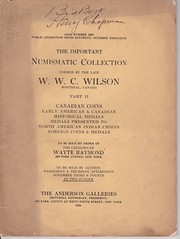
I want to send a big thumbs-up to Tom Wetter and his work on the NBS Wiki website. In particular, the page regarding the W.W.C. Wilson sales helped me with research regarding a new find: (photo attached).
I also learned that Chapman Bid Books for the Wilson sales #3 and #4 were part of the John .J. Ford library Part 1, sold by G.F. Kolbe in 2004.
Do any E-Sylum readers know of a Chapman bid book for WWCW sale #1?
To read the complete article, see: hwiki.coinbooks.org/index.php/THE_COLLECTION_OF_WWC_WILSON
ERIC NEWMAN WEEK IN BERGEN COUNTY, NJ
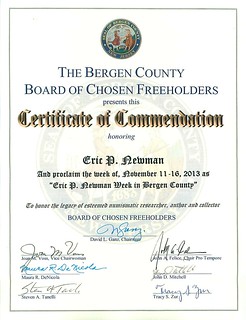 Maureen and Stuart Levine forwarded a copy of a certificate of commemoration honoring numismatist Eric P. Newman and proclaiming the week of November 11-16, 2013 "Eric P. Newman Week in Bergen County", adding
Maureen and Stuart Levine forwarded a copy of a certificate of commemoration honoring numismatist Eric P. Newman and proclaiming the week of November 11-16, 2013 "Eric P. Newman Week in Bergen County", adding
We thought it was a very nice gesture by David Ganz.

ANS PUBLISHES EDWARD SAWYER’S NATIVE AMERICANS MEDALS ONLINE
 The ANS is pleased to announce that it has digitized its entire collection of Native American medallic portraits by Edward Warren Sawyer (1876–1932). This exceedingly rare collection of uniface medals was produced in the first decades of the twentieth century as an attempt to preserve the likenesses of prominent Native Americans in a medium acceptable to them.
The ANS is pleased to announce that it has digitized its entire collection of Native American medallic portraits by Edward Warren Sawyer (1876–1932). This exceedingly rare collection of uniface medals was produced in the first decades of the twentieth century as an attempt to preserve the likenesses of prominent Native Americans in a medium acceptable to them.
Many Native Americans at the time were averse to photography. Sawyer was inspired in part by a more limited series of the Native American medallic portraits by Olin Levi Warner (1844–1896) produced in the 1890s (see for example, ANS 1921.95.1). A student of Hermon Atkins McNeil at the School of the Art Institute in Chicago, Sawyer set out to Arizona in 1904, where he spent time with Elbridge Ayer Burbank (1858–1949) a noted painter of Native Americans. Over the course of the next decade, Sawyer made multiple trips to the west, living with over a dozen tribes and sculpting over 40 individuals.
Very few of Saywer’s medallic portraits exist. Only the ANS and the numismatic section of the Smithsonian Museum hold (near) complete collections.
To view the ANS’s collection of Sawyer’s medals, click here:
numismatics.org/search/results?q=artist_facet
%3A%22Sawyer%2C+Edward%22+AND+department_facet
%3A%22Medal%22
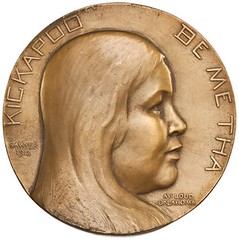
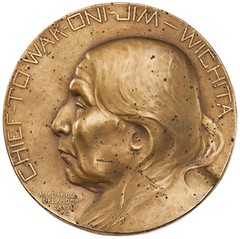
MORE ON MARY B. BLANKENBUEHLER
Last week Mike Paradis asked about "M. B. Blankenbuehler", wondering if the "M" could be for Mary Blankenbuehler of Washington County Pa. which is where he purchased the Chapman Stickney sale catalog with the name.
Michael Luck located the following. Thanks!
1929 Ninth Street School Class
These pictures came from the estate of Miss Mary B. Blankenbuehler who was a teacher at the Ninth Street School.
Miss Mary B. Blankenbuehler was a resident of Elco, PA
and passed away in 1961.

To read the complete article, see:
Charleroi PA
1929 Ninth Street School Class
Submitted by Patricia Wilson
(webcache.googleusercontent.com/search?
q=cache:wVn6OmSy15sJ:freepages.genealogy.rootsweb.ancestry.com
/~florian/o_f3/charleroi_pa/photos/ninth-st-school-charleroi-pa
-oct-1929_LARGE.htm+&cd=1&hl=en&ct=clnk&gl=us&client=firefox-a)
To read the earlier E-Sylum article, see: COLLECTOR MARY B. BLANKENBUEHLER INFORMATION SOUGHT (www.coinbooks.org/esylum_v16n45a14.html)
MOUNT RUSHMORE QUARTER LAUNCH CEREMONY
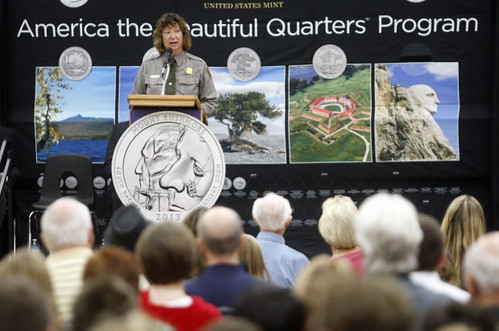
The last time Nick Clifford drove to work on Mount Rushmore National Memorial in 1940, a quarter bought more than $4 in today's money.
Now a quarter can't buy a pack of gum in a Custer convenience store.
Never mind that. What's important with today's quarter is that Mount Rushmore is back on it.
And Clifford, the last living worker on the monument, celebrated the newest coin Wednesday morning at the National Guard Armory in Custer.
With the pomp of a graduation ceremony, officials from the U.S. Mint and Mount Rushmore stood before Custer and Hot Springs students and unveiled the new quarter. The children in attendance were each given a quarter after the ceremony, and members of the public were able to buy $10 rolls and commemorative sets.
The new coin is part of the mint's "America the Beautiful Quarters" program, which celebrates one national site in each state.
South Dakota is the last of five 2013 dated quarters to be unveiled this year, coming after Fort McHenry National Monument in Maryland, Great Basin National Park in Nevada, Perry's Victory and International Peace Memorial in Ohio and White Mountain National Forest in New Hampshire.
The Mount Rushmore quarter harkens back to the monument's construction, featuring scaffolding and a worker hanging from a harness underneath Thomas Jefferson.
"I really think it's kind of cool that they put the carvers in there," said Marsha Leininger, who bought a couple of $10 rolls after the ceremony.
Clifford, 92, worked on the memorial between 1938 and 1940. After the ceremony, he signed rolls of quarters bought by members of the public and posed with people for photos, including one with Rapid City Mayor Sam Kooiker.
The last time the four carved presidents graced a quarter was in 2006, when each state quarter featured a unique design for the reverse, or tails, side. That one featured a portrait shot of Mount Rushmore, along with grains of wheat and a Chinese ring-necked pheasant, which was imported here in 1898.
In 1991, two coins in a three-coin commemorative edition featured Mount Rushmore, according to Michael White, a spokesman for the U.S. Mint. That uncirculated edition featured the monument on a silver dollar and a half dollar. The third, a $5 gold coin, featured an eagle.
To read the complete article, see:
The stone face of Mount Rushmore featured on the latest quarter
(rapidcityjournal.com/news/local/the-stone-face-of-mount-rushmore
-featured-on-the-latest/article_7e555256-dda9-596f
-a719-5b253f3e5abd.html)
Quick Quiz Answers
Phil Iversen was the only reader to reply on this topic. He writes:
The Lincoln Memorial Cent and the South Dakota Statehood Quarter come to mind.

To read the earlier E-Sylum article, see: THE MOUNT RUSHMORE FIVE-OUNCE SILVER COIN (www.coinbooks.org/esylum_v16n45a12.html)
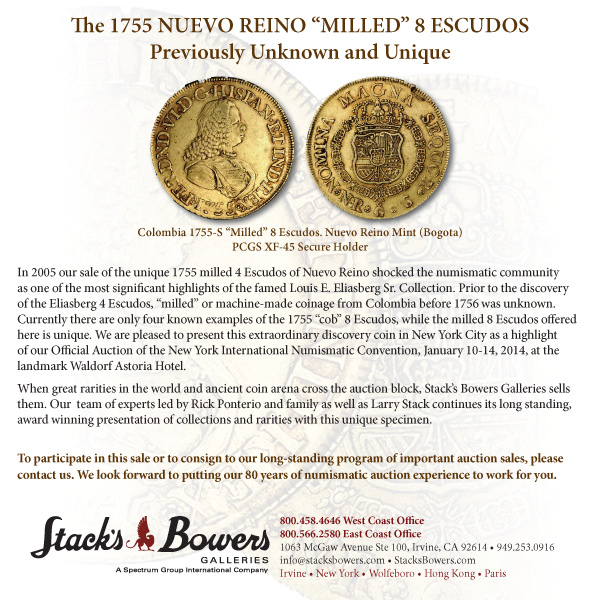
AUSTRALIA'S FANTASY GOOSE DOLLAR COINS
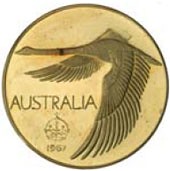 Three specimens of one of Australia’s iconic “coins” was featured in Noble Numismatics’ August sale in Melbourne. One was an extremely rare gold example, the other two silver. The gold piece sold for $22,135 on an $8,000 estimate. The better of the two silver realized $1,631 on a $1,250 estimate.
Three specimens of one of Australia’s iconic “coins” was featured in Noble Numismatics’ August sale in Melbourne. One was an extremely rare gold example, the other two silver. The gold piece sold for $22,135 on an $8,000 estimate. The better of the two silver realized $1,631 on a $1,250 estimate.
The “coin” is a fantasy piece produced when Australia converted to decimal currency in 1966, but with no dollar coin. So a magazine contest ensured to create a pattern crown-sized dollar coin that might fill the gap.
The winning design by a country mile was that of the late Andor Meszaros. It was way ahead of its time. The obverse showed an Australian Black Swan in flight along with a crown, date and the simple legend: AUSTRALIA. The reverse displayed a spray of eucalyptus (Australian gum tree) flowers and leaves along with the numerals 1 0 0 writ large.
To read the complete article, see: Fantasy Coin Evokes Canada’s Goose Dollar (www.numismaster.com/ta/numis/Article.jsp?ad=article&ArticleId=27377)
2014 BASEBALL COIN CHALLENGES U.S. MINT STAFF

Anticipated technical challenges associated with producing commemorative coins with a concave obverse and convex reverse led U.S. Mint officials to begin research and development for the 2014 National Baseball Hall of Fame coins long before final designs were approved.
Because designs had not been selected, early testing required the use of what are called “nonsense dies,” which bear designs that are in semblance of coin designs but do not duplicate any actual coin designs. For the Baseball coin program, the Mint selected nonsense designs with a sports theme.
Nonsense designs, “featuring an 8-ball reverse and pool shooter obverse, were traditionally sculpted, 3D scanned and then digitally recreated to start the process,” said Steve Antonucci, branch manager for Digital Development, Research & Development for the U.S. Mint at Philadelphia. “These designs were intended to simulate dome configurations and height of relief details that might be encountered when the baseball designs were finally approved and sculpted.”
Antonucci said the designs were then machined on computerized numerically controlled milling equipment “directly into die form to speed up the coinability and die testing phases.”
The creation of the nonsense dies represents the first time, according to Antonucci, that the U.S. Mint has CNC-milled original dies for such a purpose.
“The efforts we’ve undertaken to produce these coins reflect the passion, pride and professionalism that the men and women of the Mint have for their work,” said Tom Jurkowsky, director of corporate communications for the U.S. Mint. “What we’ve done to prepare to mint the baseball coins may be viewed as being extraordinary. But it’s really demonstrative of how we approach all of our products with only the strongest possible commitment to quality and excellence.”
In an Oct. 18 telephone interview, Antonucci said the nonsense dies, which he prefers to refer to as “research dies,” bear a pool player on the concave obverse. The convex reverse on the research die depicts an 8-ball billiard ball. Stitching was placed around the circle of the 8-ball design on the research die reverse to simulate a baseball and provide Mint technicians information on die stress issues.
When the common obverse and reverse designs were selected for the coins, testing could continue using those designs.
The adopted common obverse, approved Sept. 9 and announced Oct. 15 for the gold $5 half eagle, silver dollar and copper-nickel clad half dollar, bears a baseball glove design.
The design was created by San Luis Obispo, Calif., artist Cassie McFarland, who will received $5,000 for winning the open design competition from which her design was selected.
The adopted common reverse, bearing a mandated rendition of a baseball similar to that used by Major League Baseball, is the work of U.S. Mint Sculptor-Engraver Donald Everhart II.
Everhart sculptured both obverse and reverse designs.
To read the complete article, see: Baseball coins prove technical challenge for U.S. Mint staff (www.coinworld.com/articles/baseball-coins-prove-technical-challenge-for)
U.S. MINT TEAMS WITH NATIONAL ENDOWMENT FOR THE ARTS

(Image: A United States Mint artist manually sculpts the 2013 Native American reverse design. She begins the sculpt in plastilene, then casts to a negative plaster and finishes the model up in the positive plaster. Photo courtesy of the United States Mint.)
The United States Mint has teamed up with the National Endowment for the Arts to announce a rather unusual open call for artists. The prize isn’t a place in an exhibition or grant, but a contract-based employment opportunity to create designs for U.S. coins and medals. Open to any U.S. citizen working in the arts, a one-year contract will be awarded to up to 20 artists to be included in the Mint’s Artistic Infusion Program (AIP), where they will submit designs in response to various commissions. In addition to the commission fees, the artists will receive an additional $5,000 for each of their submissions chosen for production.
In partnering with the NEA, the Mint hopes to reach a broader selection of artists who focus on a unique and powerful use of symbolism.
“I am thrilled that this program will present the creativity and vision of contemporary American artists in both the coins that we use every day, as well as in the medals that will be used to mark occasions and accomplishments of great importance,” NEA senior deputy chairman Joan Shigekawa said.
If patriotic small-scale relief sculpture is something you might like to design, the Mint and the NEA will be holding a webinar from 4-5pm (Eastern Standard Time) on December 11, in which they will outline the submission process. Applications will be accepted until January 10, 2014.
To read the complete article, see:
The U.S. Mint Is Looking for Artists to Liven Up Its Coins and Medals
(blogs.artinfo.com/artintheair/2013/11/07/
the-u-s-mint-is-looking-for-artists-to-liven-up-its-coins-and-medals/)
THE BOOK BAZARRE
INTERNET ARCHIVE SCANNING CENTER BURNS
The Archive operates a scanning center that was affected this week with one of a bibliophile's greatest fears: fire. Here's an excerpt from Brewster's November 6th blog post. -Editor
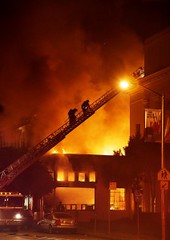 This morning at about 3:30 a.m. a fire started at the Internet Archive’s San Francisco scanning center. The good news is that no one was hurt and no data was lost. Our main building was not affected except for damage to one electrical run. This power issue caused us to lose power to some servers for a while.
This morning at about 3:30 a.m. a fire started at the Internet Archive’s San Francisco scanning center. The good news is that no one was hurt and no data was lost. Our main building was not affected except for damage to one electrical run. This power issue caused us to lose power to some servers for a while.
Some physical materials were in the scanning center because they were being digitized, but most were in a separate locked room or in our physical archive and were not lost. Of those materials we did unfortunately lose, about half had already been digitized. We are working with our library partners now to assess.
The San Francisco Fire Department was fast and great. Our city supervisor and a representative of the mayor’s office have come by to check up on us. There has been a pulling together on the Internet as news has spread.
This episode has reminded us that digitizing and making copies are good strategies for both access and preservation. We have copies of the data in the Internet Archive in multiple locations, so even if our main building had been involved in the fire we still would not have lost the amazing content we have all worked so hard to collect.
An early estimate shows we may have lost about $600,000 worth of high end digitization equipment, and we will need to repair or rebuild the scanning building.
To read the complete article, see: Scanning Center Fire — Please Help Rebuild (blog.archive.org/2013/11/06/scanning-center-fire-please-help-rebuild/)
WAYNE'S NUMISMATIC DIARY: NOVEMBER 10, 2013
This week brought the Whitman Expo to the Baltimore Convention Center. It's not quite in my back yard, but close enough that I was able to get there a couple days this week.
The show wasn't yet open on Wednesday, but I went up late in the afternoon to visit the lot viewing room for the Stack's Bowers auction. There I met up with Vicken Yegparian and Brian Kendrella to chat for a bit about a web site project I'm working on. It was the first chance I'd had to meet Brian, and I hadn't seen Vic in ages. I enjoyed our time together. All the while, the lot viewing room was quite busy with prospective viewers.
I couldn't make the show Thursday, but left work early Friday to head back up to Baltimore. I walked in on the upper level and noticed a familiar face thru a window on a conference room door. It was former Chief Engraver John Mercanti giving a presentation. I slipped inside and took a seat.
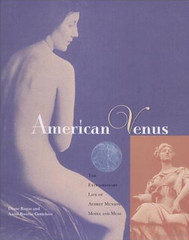 I'd missed much of his presentation, but he caught my attention when he recommended a book I'd never heard of before: American Venus. It was a biography of model Audrey Munson. Mercanti was discussing her because she was a model for the Walking Liberty Half Dollar which in turn became the model for his American Eagle bullion coin.
I'd missed much of his presentation, but he caught my attention when he recommended a book I'd never heard of before: American Venus. It was a biography of model Audrey Munson. Mercanti was discussing her because she was a model for the Walking Liberty Half Dollar which in turn became the model for his American Eagle bullion coin.
Back at home the next day I grabbed my copy of Roger Burdette's Renaissance of American Coinage 1916-1921, but didn't find Munson or the book in the index or bibliography. So I checked with Roger, who writes:
I've seen the book. I didn't cite it because it had nothing useful for the book I was writing. I found nothing in Weinman's papers to indicate that he used any specific model for the half dollar.
Mercanti did say that he and other artists often use composite models rather than any single person. So it may well be that Munson sat for Weinman at some point, but other models may have, too. John told the group a great story of how he used to commute to the Mint on public transportation, and would find himself staring at a stranger who had just the right nose he wanted to use in his work.
I wasn't the only straggler at Mercanti's talk. Soon in walked an old friend from Pittsburgh, Richard Jewell, and not long after him came former Mint Director Ed Moy. I'd met Ed back before he left the Mint, when he came as my guest to a dinner meeting of my numismatic social club, Nummis Nova. And soon it dawned on me that the person manning the computer to run John's slides was none other than Dennis Tucker from Whitman Publishing.
John had some extra time and gave us highlights from another presentation of his on moving the Mint into the digital age. He started by describing the mint's six Janvier reducing machines, which were quite old, clunky, slow and prone to breakdowns. His bosses had told him, "Either that machine (the Janvier) goes into the Smithsonian, or you will." So he started learning what digital technology could do.
He purchased a good copy of the bust of Michelangelo's David and began asking all new sculptor-engravers to model it using computer tools. The task often took a couple weeks given all the detail involved. Some of them did very well, and one woman outshone them all. Many of the older engravers couldn't or wouldn't learn the technology, but it became mandatory for the new generation.
After John concluded I spoke to Rich and his wife for a while, and grabbed Mercanti to ask him to sign my copy of the first edition of his book on the Silver Eagles, which he kindly did.
My next mission was to find Q. David Bowers. He told me I could track him down at the Stack's-Bowers or Whitman booths, but he wasn't there. I walked around the bourse floor visiting some other folks, but many were busy with customers, including Julian Leidman, Wayne Herndon, Dave Perkins, and John Kraljevich. I did get to say hello to Tony Terranova, and then made my way back to literature dealer John Burns' table.
John was still looking a bit peaked, but he was set up at the show in his usual spot. We talked a while and kibitzed with other bibliophiles who came by, including Phil Carrigan and Barry Tayman. Next I stopped at Charlie Davis' table. I learned Dave Bowers had been spotted recently on the bourse floor, and set off again in search of him.
Near the Whitman booth I happened to turn to my left and realized I was standing next to David Sundman. We chatted a bit and he helped me track down the elusive QDB. We found him upstairs outside the auction room. The three of us settled into some chairs and had a wonderful conversation.
Dave showed us a rare National Bank Note from the Territory of Colorado that he'd bought on the bourse floor. We talked about Sundman's Massachusetts silver coins in the evening's sale. Other topics included The E-Sylum, Dick Johnson, and the vast difference in coin prices since QDB began his career as a dealer. Chris Karstedt joined us for a while, too. It was a very enjoyable interlude.
The rest of the afternoon was a blur. I made a quick stop at John Kraljevich's table, and he was busy with customers as usual. I looked for Dave Perkins but he was away from his table for a club meeting. Next I visited for a bit with Dave Lange at the NGC table.
My next stop was the American Numismatic Society reception, where I was among the first people in the room, along with Ray Williams and Syd Martin. We talked for a bit as Ray slowly dismantled a copy of the convention auction catalog, taking away the pages that didn't pertain to his interest in U.S. colonial coins. Great way to save shelf space, but painful for a bibliophile to watch. I teased him that I'd "write him up", but I don't have the authority to give him a ticket or a fine. He's still my favorite colonial guy, an energetic booster for the specialty.
Several of us stacked the chairs against the wall to make room for mingling. Soon the catering staff rolled in tables of appetizers and a bar, followed by a small hoard of ANS members. I teased Barry Tayman that I'd known "I'd have to elbow you out of the way to get at the bar." Soon I was chatting with David Gladfelter and introducing him to Jon Radel. Before leaving I spoke with ANS Executive Director Ute Wartenberg Kagan for a bit. She later told me:
It was a fantastic show for me and ANS. We sold almost $8,000 worth of books and got a few new members. This won't be our last event here.
It was now time for dinner and I raced down to the lobby to meet up with Dave Lange, Len Augsburger, Dave Perkins and his friend Mike Clark, who collects early U.S. quarters and numismatic literature among other items. We walked down the street to the Pratt Street Ale House, where I'd made reservations. Waiting for us were Eric Schena and his wife Heather. Soon the seven of us were seated at a table. Still pretty full from a late lunch at Chipotle, I only ordered an appetizer.
Conversation was all over the numismatic map, from Eric Newman's collection, Col. E.H.R. Green, John J. Ford, Dave Perkins' Civil War token research, Heather's undertaker tokens, and how Dave Lange visited Walter Breen in jail to discuss Buffalo Nickel research.
It had been a long day for everyone and the group scattered after finishing our meals. But I had one more stop. I'd arranged to meet Dennis Tucker after dinner. I called him and he directed me to Sullivan's, a great restaurant on the other side of the convention center. When I arrived his group was just finishing dinner. And what a group it was - Dave Crenshaw and Lori Kraft of Whitman Expos, Dawn Burbank of Whitman Publishing and her husband Shane, Stephen Pirtle and Tabitha Campbell of Anderson Press, plus guest authors Ed Moy and John Mercanti (and his wife Marianne). The waiter set a chair for me at the end of the table next to John's wife.
I'd just missed several stories Ed told of his days leading the Mint. But it was still nice to see him, and I was able to talk a bit with John Mercanti and his wife. Since the side dishes at Sullivan's are served family style, plates were passed down the table and I snacked on some leftovers. At our house it's always my son Christopher who wolfs down everyone else's food. Luckily there wasn't much as I still wasn't very hungry. But I made room for the next course - dessert! I had a great piece of cheesecake with strawberries.
After the group split up, Dennis Tucker and I relocated to the bar for a drink. I allowed myself just one beer, since I still had a long drive home ahead of me. We chatted for a good while until it was time to go. I got to my car by about 11pm and somehow made it home by midnight - ah, the joys of Beltway driving without all the other damn cars on the road!
My numismatic day wasn't over, though. When I got home, a box from Stack's Bowers was awaiting me. It contained the three latest hardbound catalogs of the John J. Ford collection sales. That was an even better way to end the day than cheesecake. Many thanks to everyone I saw this week; it was a delight to talk with so many wonderful fellow numismatists.
ALAN WEINBERG'S NOVEMBER 2013 BALTIMORE SHOW REPORT
Late Saturday night I returned from the November Whitman Baltimore show. While most dealers I talked to claimed that attendance was down, I was quite pleased. There was a large group of people waiting to get in at 12 noon the first day and I paid the $50 Early Bird (on line discount) as did quite a few others for a 10 AM entry. It's always worth it.
I rank the March and Nov Whitman Baltimore shows right behind the summer ANA and the winter Orlando FUN show for interesting and rewarding bourse pickings and attendant auctions.
 This year the C-4 Colonial convention was in conjunction with the Baltimore show and there was a good attendance of fervent state coinage "nuts". The much-anticipated Siboni-Howes-Ish composed American Numismatic Society New Jersey colonial copper cent book first appeared at the show. A massive and visually impressive book, which approaches the weight and heft of Dave Bowers' California Gold Rush book, made its debut at the show. Cost to C-4 and ANS members is almost $170 but it flew off the shelves at ANS' show booth and all 100 copies they brought to the show sold out! Quite a feat given the cost, specialty interest and the isolated location of the ANS booth way in the back. Reportedly only 500 copies may be printed en toto and it may well sell out.
This year the C-4 Colonial convention was in conjunction with the Baltimore show and there was a good attendance of fervent state coinage "nuts". The much-anticipated Siboni-Howes-Ish composed American Numismatic Society New Jersey colonial copper cent book first appeared at the show. A massive and visually impressive book, which approaches the weight and heft of Dave Bowers' California Gold Rush book, made its debut at the show. Cost to C-4 and ANS members is almost $170 but it flew off the shelves at ANS' show booth and all 100 copies they brought to the show sold out! Quite a feat given the cost, specialty interest and the isolated location of the ANS booth way in the back. Reportedly only 500 copies may be printed en toto and it may well sell out.
Is the book worth it? Well, I have a marginal interest in Jersey coppers - much more so in Massachusetts colonial silver and Washingtonia - but I couldn't keep my hands off this book and it filled most of my five hour flight back home . What quality throughout! Lest readers think the text would be boring and technical, not so! There are plenty of engrossing stories about new discovery, acquisition, personality conflicts among dealers and collectors, and histories of prominent and long-dead numismatic personalities. A really engrossing read.
Though printed in China (which kept costs down) I could not find any fault with the strong binding, printing or photographic images, most superbly done by Neil Rothschild. This is, in my opinion, a must-have book for any moderately advanced dealer or collector.
 I attended the Stack's Bowers auction of Dave Sundman's Massachusetts silver collection (I'd sold him two of the coins) and it was eye-opening. A full to overflowing auction room, standing room only, and prices were through the roof except for the Willow Tree sixpence which was a good buy at approx. $230K hammer. One dealer representing a new colonial collector dominated the bidding and bought most of the pieces. Dave Sundman was ecstatic over the sale results, given his 10 year-only investment.
I attended the Stack's Bowers auction of Dave Sundman's Massachusetts silver collection (I'd sold him two of the coins) and it was eye-opening. A full to overflowing auction room, standing room only, and prices were through the roof except for the Willow Tree sixpence which was a good buy at approx. $230K hammer. One dealer representing a new colonial collector dominated the bidding and bought most of the pieces. Dave Sundman was ecstatic over the sale results, given his 10 year-only investment.
I personally acquired six really rare and many borderline unique medals privately and on the bourse floor and was quite pleased. Unique items really do surface at Baltimore, an old numismatic center of activity from many years ago. I just cannot comprehend collectors remaining at home and sitting in front of their eBay when you can learn so much, renew old friendships and acquire such rarities when you attend a show. There is simply no comparison.
To view the full Sundman Willow Tree Sixpence lot description, see: Lot #4003. 1652 Massachusetts Bay Colony Willow Tree Sixpence. Noe 1-A, Salmon 1-A, W-130. Rarity-6. AU-53 (PCGS). Secure Holder. (stacksbowers.com/Auctions/AuctionLot.aspx?LotID=561574)
DAVID SUNDMAN'S MASSACHUSETTS SILVER POST-AUCTION REPORT
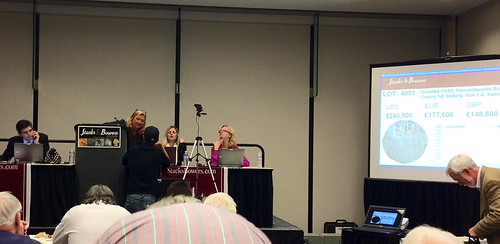
When I first started collecting Massachusetts Bay Colony silver series in January 2004 I was lucky to have Dave Bowers, Lawrence Stack, Alan Weinberg, Tony Terranova, and John Kraljevich available to lean upon for advice. Each was generous with information and the insight they’d gained over many years in the field. They gave me lots of encouragement to collect. This was very helpful to me as a newcomer to colonials, and I thank them for that.
Other than the odd duplicate banknote or coin that I’ve sold over the years (usually as a result of an upgrade), I had only sold one major collection of mine at auction prior to this. That was my U.S. Paper Money Type collection that I sold at auction through Lyn Knight in the beginning of 2001. Lyn did a first class job.
I am fortunate to have known Dave Bowers and Chris Karstedt for many years, and we are good friends. When I decided to shift my collecting of Massachusetts silver to type collecting of U.S. Colonials, I felt very comfortable consigning one of my favorite U.S. coin collections to Stack’s Bowers. I knew everything would be done well, and it would be a first class effort. I think the catalog they produced is top flight.
Last Friday night At 6:00 pm, I entered room 304 of the Baltimore Convention Center, and was surprised to find that there were only a few seats available. In fact, it was standing room only, with many people looking on through the doorway. This is most unusual today, with so many participating by phone, and bidding on-line via the web. I managed to find a seat next to Tony Terranova, and the sale began.
I tracked the 18 lots carefully, and watched and listened to the bidding. The high point for me was when we got to lot 4010, the 1652 Massachusetts Bay Colony Pine Tree Shilling. Large Planchet. Noe-1, Salmon 1-A, W-690. Rarity-2. Pellets at Trunk. MS-62 (PCGS). The bidding had nearly closed, when Dave Bowers said “Can I add a few words about this coin..” and went on to tell those gathered that the type is was one of the top favorites of Mr. Eliasberg, of Ken Bressett, and Dave Bowers. After the little speech about the joys of Noe 1-A, the coin brought another round of bidding and eventually sold for $49,938.00, all-in with the Buyer’s Fee.
Now that it is all over, I do confess that prior to the sale, I was a bit nervous about the first three lots—would other collectors like them as much as I did? In the end I did not need to be concerned as these first three coins realized $992,875 combined, including Buyer’s Fees.
According to the listed final bids on the Stack’s Bowers website the preliminary total for my collection, consisting of lots 4001-4018 (18 coins) is $1,363,295 with buyer’s fees.
David Bowers, Chris Karstedt, and the entire Stack’s Bowers team did a wonderful job with the detailed catalog descriptions, the photographs, and getting the word out about the sale. Dave and Chris were a joy to work with from beginning to end. I am still collecting colonials; I was bidding on other U.S. colonials and tokens and got a few of them to add to my collection. It was a great night!
To read the complete lot description for Dave's Noe-1 NE Shilling, see: Lot #4010. 1652 Massachusetts Bay Colony Pine Tree Shilling. Large Planchet. Noe-1 (stacksbowers.com/Auctions/AuctionLot.aspx?LotID=561581)
THE BOOK BAZARRE
THE FAMED FORGER JOSEPH-SAMUEL FARINET
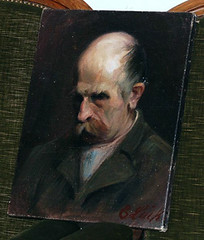 In the 1870s the Swiss Cantonal Bank of Valais experienced a crisis after a serious row of bad speculations. The inhabitants of the Valais therefore had not much confidence in paper money issued by the Bank. They preferred coins – even though they were forged. This psychological starting situation came in handy for a cunning Italian forger who had flown from his native country into the impenetrable valleys of southern Switzerland evading thus police: Joseph-Samuel Farinet.
In the 1870s the Swiss Cantonal Bank of Valais experienced a crisis after a serious row of bad speculations. The inhabitants of the Valais therefore had not much confidence in paper money issued by the Bank. They preferred coins – even though they were forged. This psychological starting situation came in handy for a cunning Italian forger who had flown from his native country into the impenetrable valleys of southern Switzerland evading thus police: Joseph-Samuel Farinet.
Farinet was born son to a blacksmith in the Aosta Valley in 1845 a fact which may have favoured his coining talents. Anyway, he was productive in the Valais for quite a long period.
His forged coins are said to be excellent and he is often compared with Robin Hood. However, his donations to the poor probably were not without ulterior motives:
In the end he needed help not only with the production (personally he used to make only the dies while others made the coins in various hidden places) but also a broad solidarity among the population. Thanks to that he would move quite freely and without fearing the authorities. Nevertheless having been jailed a couple of times he always succeeded in escaping – among others he was supported by one of his many mistresses. In the course of a decade reportedly the 20 Rappen pieces which had become his speciality and were thus called also ‘Farinets’ after their maker constituted about one third of all coins circulating in the Valais!
As with his English equivalent Robin Hood just after Farinet’s mysterious death he started to become a true legend. In the 1930s a book and a film of his life were successful and today one may still see numerous intriguing objects concerning the forger’s life and numismatic products in the local forgery museum.
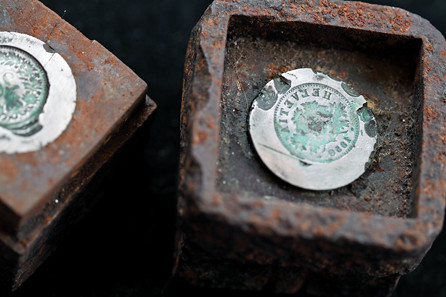
To read the complete article, see: Farinet: Legendary forger in Valais (www.coinsweekly.com/en/News/4?&id=2397)
SPANISH PROTESTERS PUTTING COMPLAINTS ON BANKNOTES
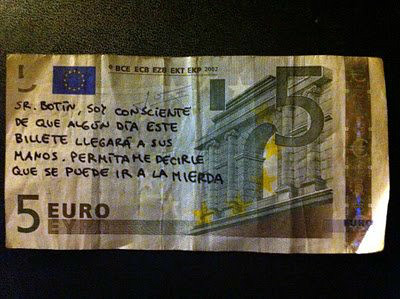
Fed up Spaniards are using a new and creative way to express their anger against bankers and politicians who they hold responsible for the current economic crisis: they are defacing euro banknotes with criticism.
Such small acts of graffiti are finding their way through pockets and cash registers as well as across social networks. Despite ‘putting their mouths where their money is the protesters can still use the money as legal tender.
To read the complete article, see: Message in a banknote for angry Spaniards (www.euronews.com/2013/11/04/message-in-a-banknote-for-angry-spaniards-/)
THE PERTH REGIMENT ITALIAN LIRE SHORT SNORTER

This story has its start on eBay.
It was there, a few years ago, former Wellander Bobby Morrison’s eye was snagged by a war-time 100-lire Italian bank note where the words ‘Port Colborne’ were inscribed.
With them, a name: Arthur Diwell.
It was one of 22 names scrawled on the note. Fifteen on its front, seven on the back, where Diwell’s was written.
Along with the 22 names were three sentences: Say Hello to the devils for me; Plenty of vino down there; Passport to Hell.
The signed notes are called “short snorters” says Morrison. It’s a term given to bank notes which circulated during the Second World War, signed by soldiers who travelled together.
“I thought the note would be nice to buy and send to the family as a memory,” Vancouver-resident Morrison said in an e-mail.
He has a soft spot in his heart for Canadian military history, which has become his hobby.
“Finding little bits of history here and there has been somewhat of a fetish, as anyone in this hobby can attest to,” he said.
His research tracked down one of Arthur Diwell’s descendants, son Bob. Through their phone chatting, Morrison learned infantryman Arthur Diwell had been killed in action at the Battle of the Fosso Munio, Dec. 20, 1944. That led to more research with Morrison ascertaining that 18 of the 22 names on the note were those of Perth Regiment members. The regiment fought gallantly in many battles in Italy, paying a high price in some.
“I paid $5 for that note, but there’s probably $5 million worth of stories in it,” he said.
Morrison, who grew up in Summerlea Subdivsion on Quaker Rd., a Veteran’s Land Act post-Second World War development, also learned Diwell had two daughters: Barbara and Kay, and wife Emma.
Recently, he made three large photocopies of what he has come to call The Perth Regiment Italian Lire Note as keepsakes for the three survivors.
Kay Diwell Boss, the youngest of the three children, did not know her father. Born in July, 1944, she was five months old when he was killed.
To read the complete article, see: A bank note worth millions in memories (www.stcatharinesstandard.ca/2013/11/08/a-bank-note-worth-millions-in-memories)
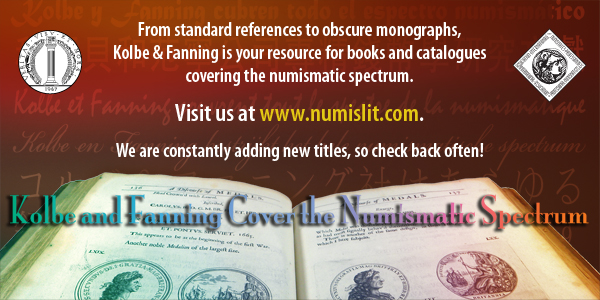
THE BRITISH NAVAL GENERAL SERVICE MEDAL
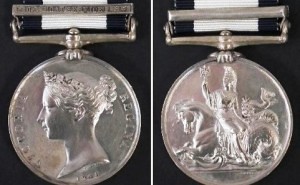
A medal awarded to a Royal Navy hero from the second War of Independence in 1812, is to go on sale at a Nantwich auction.
The medal is expected to fetch around £10,000 when it goes under the hammer at Peter Wilson auctioneers on Market Street November 27-28.
The Naval General Service Medal 1793-1840 was awarded to James McCoy, who with his comrades rowed for 36 hours without rest before attacking the American flotilla.
McCoy was one of 1,200 sailors and Royal Marines who formed the British force at the Battle of Lake Borgne. The action was part of the advance on New Orleans on December 14, 1814.
The main battle commenced at 10.30am with the British boats divided into three divisions headed respectively by Captains Lockyer, Roberts and Montresor.
The British then began another punishing row towards the American flotilla battling against a heavy current, as well as enemy rounds and grapeshot fire.
Two British boats were sunk during the advance as well as many men killed and wounded including most of the crew of Lockyer’s boat.
But they succeeded in boarding and capturing the American Gunboat No 156 and turned her broadsides against her own ships.
Following savage close combat with muskets and bayonets, cutlasses and pikes, the British succeeded in capturing the remaining American vessels one by one in a fight which lasted only five minutes.
The American vessel Tickler, which observed the battle from a short distance behind the flotilla, was scuttled by her captain to avoid capture.
The battle lasted for two hours and saw 10 American and 17 British killed, and many wounded including Captain Lockyer.
In 1847, the Royal Navy issued survivors of the battle with a bar to the Naval General Service Medal impressed with the wording “14 Dec. Boat Service 1814″.
It was claimed by 205 survivors, making examples today extremely rare.
To read the complete article, see: Rare War of Independence medal to fetch £10,000 at Nantwich auction (nantwich-news.co.uk/wordpress/2013/11/04/rare-war-of-independence-medal-to-fetch-10000-at-nantwich-auction/)
EURO COINS COST TWICE FACE VALUE TO MINT
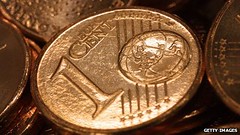 Italy spends more minting small change than the coins are worth, it seems.
Italy spends more minting small change than the coins are worth, it seems.
MPs have reportedly been grumbling about the price of minting one-cent coins, saying each costs more than four cents to make. Left Ecology Freedom party treasurer Sergio Boccadutri told MPs the margin for larger denominations was not much better - 5.2 cents for each two-cent coin and 5.7 for five-cent pieces - dubbing the whole process "incredible", according to the Rai News 24 TV channel. Boccadutri says his calculations suggest that the state mint has made various cent coins to a total cost of 362m euros since the adoption of the single currency in 2002, even though the coins themselves have a face value of only 174m.
They're not the first politicians to question the value of producing small coins. The US has been toying with the idea of scrapping its "penny", given it costs almost twice its one-cent value to mint, according to Bloomberg. Canada and Australia have already scrapped their smallest coins. In the UK, the Royal Mint is tight-lipped about production costs. However, the Independent has suggested the British penny's face value is three times what it costs to make.
To read the complete article, see: Italy: Minting euro cents 'costs four times their value' (www.bbc.co.uk/news/blogs-news-from-elsewhere-24819165)
FLORIDA STATE UNIVERSITY CHALLENGE COINS
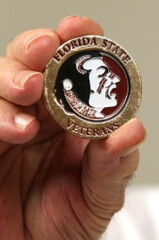 For Ted Rybicki the GI Bill and FSU made all the difference. Now, if challenged, he can prove it.
For Ted Rybicki the GI Bill and FSU made all the difference. Now, if challenged, he can prove it.
At the annual Emeritus Alumni Luncheon held for Florida State University alumni who graduated 50 or more years ago, FSU Veterans Center director Billy Francis handed out special FSU challenge coins, or medallions, to veterans who were present, about 15 in total.
One of these recipients, Ted Rybicki, a Korean War veteran, enrolled in FSU after finishing his service in 1955. He estimates that he had finished about a year’s worth of classes while in the Air Force and was able to finish a degree in journalism in only two years at FSU in 1957. Rybicki credits his “fruitful” career in news media and public relations to the GI Bill.
“I’m very proud to be a veteran. I’m humbled to get the medallion,” he said.
According to Francis, the tradition started when a U.S. airman from a wealthy background had coins made for his company with their insignia.
At least one man kept his coin on him at all times. His plane went down behind enemy lines and, after being found by Allied forces who suspected him of being a German saboteur, he produced the coin as proof that he was an American.
“The tradition of the challenge coin goes back to WWI and they are part of military heritage,” said Francis.
To read the complete article, see: FSU salutes veterans with challenge coins (www.newsherald.com/military/top-story/fsu-salutes-veterans-with-challenge-coins-1.229542)
FEATURED WEB SITE: ALL ENGELHARD
This week's Featured Web Site is dedicated to the products of bullion product maker Engelhard. Thanks to Ken Conaway for the suggestion.This site is dedicated to the presentation and preservation of all things Engelhard. Here, you will enjoy full Engelhard biographical and company history, spanning from when Charles W. Engelhard, Senior, founded the company in 1902, and continuing to when German chemical company, BASF, purchased it in 2006. This site offers information regarding the various Engelhard ingots produced, including unique variety, weight class and country of origin.
We are a group of ingot collectors that have come together to bring forth and maintain a much-needed resource of Engelhard information. Our group has a diverse background of collecting, spanning decades, and includes members from various parts of the world, including Australia, Great Britain, Netherlands, Canada and the United States. The core of pieces presented are owned by several members of our collector group and have been shared amongst one another for study in each collector’s field of expertise. These fields include knowledge of ingot dimension and casting distinction, font study, strike characteristics, surface finish and toning, and of course photography.

allengelhard.com
